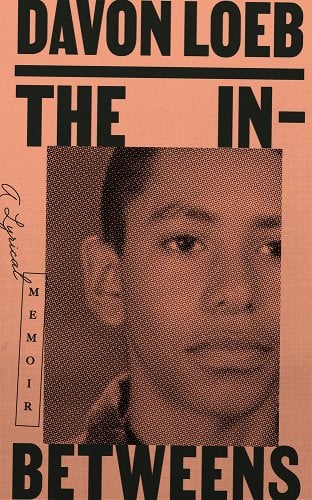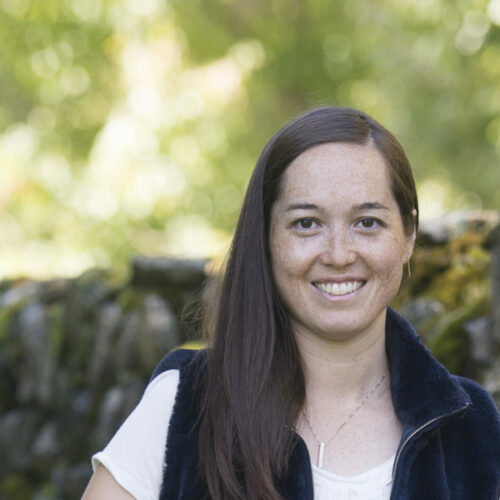Review by Anri Wheeler
 I keep meaningful quotes from writing workshops and book launches I’ve attended on Post-its around my desk. One such quote, from Lilly Dancyger, reads “End on the inhale, rather than the collapse of air.” This is exactly what Davon Loeb accomplishes at every turn in The In-Betweens: A Lyrical Memoir (West Virginia University Press, Feb. 2023). The book is a series of short bursts of essays, each self-contained, that together paint a fuller picture of Loeb’s coming of age in the Pine Barrens of New Jersey, with summers spent in Alabama. Loeb is the son of a white Jewish father and Black mother who raises him, for a time with his stepfather, after his parents’ divorce.
I keep meaningful quotes from writing workshops and book launches I’ve attended on Post-its around my desk. One such quote, from Lilly Dancyger, reads “End on the inhale, rather than the collapse of air.” This is exactly what Davon Loeb accomplishes at every turn in The In-Betweens: A Lyrical Memoir (West Virginia University Press, Feb. 2023). The book is a series of short bursts of essays, each self-contained, that together paint a fuller picture of Loeb’s coming of age in the Pine Barrens of New Jersey, with summers spent in Alabama. Loeb is the son of a white Jewish father and Black mother who raises him, for a time with his stepfather, after his parents’ divorce.
Loeb’s writing comes to life in the details, from the imagined smell of his mother’s lotion when his parents are courting, to the reverberations of getting his first tattoo in the back room of a trailer at age 16. He also, as indicated by the title, brilliantly evokes what it means to occupy so many in-betweens. For example, his exploration of his mother’s sister, Sammy, who is both loving and neglectful, charming and unsettling, “Aunt Sammy was hard, Mom said, but her heart was soft.” Another, his astute understanding of the two father figures in his life: “One was a father and one fathered, an is and a does.”
The is versus does framing comes back to the fore in “The Best Dancer,” this time through the lens of race. Loeb finds himself in a prom dance off with AJ, one of the three other Black boys at his high school. Leading up to this scene, Loeb has deftly framed how his white peers flatten him into a seen-in-the-media-version of Blackness. After he wins the dance off, Loeb muses, “But really, AJ was the best dancer. He lost because he looked too Black, and I was just Black enough.” Loeb goes on, “AJ moved through white spaces with such grace and cultural dexterity, knowing when to be himself and when to assimilate. I had no balance between being Black and acting Black. The two were inseparable. I was just a replica of the things I saw on television.”
The power of Loeb’s writing is bound to its vulnerability: “I didn’t know who I was, or at least, where I fit into the Black narrative.” He is so adept at wading into the nuance of racial self-discovery, from the ways in which he is more palatable to his white peers—at the same time being called “white boy” when visiting his mother’s family in Alabama—all the while implicating himself too. Midway through “Thoughts on Hair,” he asks, “Because wasn’t it cool to be Black if it was cool to be Black?” He answers his own question with the chapter’s closing line, “And I’m guilty of taking on these different cultures—guilty of this appropriation, guilty of gainfully being racially ambiguous.”
The ever-present questions that wind through Loeb’s book—what it means to be a man, to be Black, to be biracial, to be Jewish—are fueled by his desire to carve out a sense of belonging. “I was the constant reminder that between the Black and white is where I planted, and I stayed…I was in the middle desperately trying to grab and hold on to something to call my own.” After a class visit to the Holocaust Memorial Museum in D.C., Loeb is moved to call his father’s mother after a gap in communication. “I wanted to feel like an insider rather than always standing on the outside looking in.”
At the same time, the grace that Loeb can extend to his family further complicates our understanding of them, and him, in meaningful ways. In “Alabama Fire Ants,” one of several pieces about his summers spent in Alabama, Loeb writes, “I came to realize that it wasn’t the ants’ fault when they attacked me; they were protecting their queen. And maybe that’s the strange nature of things—somehow if given the chance, the oppressed will always become the oppressor. So, I can’t entirely blame my family and their mistreatment of me.”
Interwoven between essays of his remembered past are those conceptualized based on stories that have been passed down to him about the lives of family members that pre-date his birth, tales that take on near mythic qualities in the retelling. These reimaginings are not limited to the years before Loeb’s birth. In “To Be A Man,” he walks us through six could-have-been vignettes with his father, written in second person. He zooms in on bedtime and Back-to-School night and Halloween with a father who shows up, asks the right questions, and gives the perfect shoulder squeeze of affirmation. A one-line ending yanks the rug out from under us, “And while none of this is true, these are some things I wish we did.”
There were times, however, when this reader needed more than the short chapter provided. The prime example was “Not the Worst of Boys,” which explores Loeb and his friends struggling to help a girl who gets drunk on their watch when they are freshly teens. The abrupt ending, coupled with the lines “we weren’t the worst of boys, but we weren’t the best,” glossed over the very explorations that make the rest book shine: the ability to wade through the messy middle, the in-betweens, while owning the ways that messiness implicates Loeb. Here, he let himself off the hook.
As Loeb comes of age, so does the narrator’s understanding of his relationship to Blackness. He sees his mother’s worry laid bare when he asks to borrow her car, “She believes it’s not a matter of if, but when. She knows she can’t protect me but hopes these stories will.” She cautions him about how his consequences will be different from his white friends. Here Loeb is “Black enough.” The essays that close the book take on a more somber tone, one that does not sugar coat the ways the question “what are you” has evolved from a constant annoyance to a marker of how Loeb and other Black men are perceived that can have life or death consequences.
In the penultimate chapter, “On the Confederate Flag,” we come full circle when Loeb’s once best friend shows up to school with the Confederate flag on his shirt. The line, “It’s always the ones closest to us that break us the most” is directed at this friend, but simultaneously evokes the myriad ways we’ve seen those from within Loeb’s own family make him feel less than. This piece also reminds the reader of another theme that runs throughout the book: the false and rigid binaries that society imposes around gender and masculinity.
Just as the images seen through a kaleidoscope add up to so much more than the sum of each small piece of glass that shifts within, each gut punch of a chapter layers onto the next leaving readers with a beautiful, and at times devastating, portrait of Loeb’s life. As a mixed-race person, albeit one with a very different story than Loeb’s, I felt seen reading this memoir. And I hesitate to write those words for fear of pigeonholing it. The In-Betweens is for anyone who’s sought to better understand aspects of their identity, who has felt the ways family and society project meaning onto these identities in ways affirming and othering. I know I will return to Loeb’s gorgeous essays and hope many readers will discover them anew, perhaps finding pieces of themselves along the way.

Anri Wheeler
ReviewerAnri Wheeler is a multiracial writer, antiracist educator, and mother to three strong daughters. Her memoir-in-progress is about race, class, motherhood, and tearing open the boxes into which we’re asked to reduce ourselves. More at anriwheeler.com.


